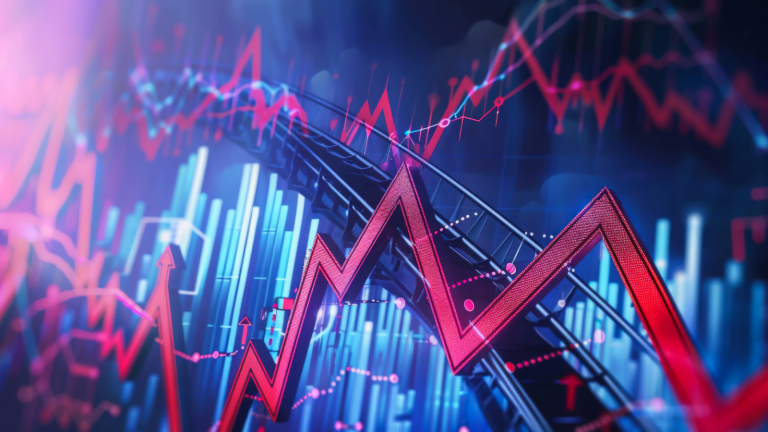Editor’s Note: In 1961, a simple rounding error led to one of the most profounddiscoveries in modern science: the butterfly effect.
Today, that same principle drives one of the biggest breakthroughs in investing. Small changes in data – a trade, an earnings call, a shipment delay – can ripple through the markets with enormous force.
TradeSmith CEO Keith Kaplan and his team have spent years capturing those ripples with advanced AI. Now, they’ve built a “Super AI” powerful enough to give everyday investors access to hedge-fund-level precision.
On Wednesday, October 15, at 10 a.m. Eastern time, Keith will show you how it takes AI-powered investing to the next level with his Super AI Trading event. You can reserve your spot for that event here.
Keith is joining us before the event to explain how “Super AI” works – and how it could help you stay a step ahead of the next market storm.
Take it away…
Edward Lorenz wasn’t looking for a big idea. He only meant to save a little time.
In 1961, the MIT mathematician was running rudimentary weather simulations on a Royal McBee LGP-30 computer. It was the size of a fridge, droned nonstop, and spat out forecasts on long rolls of paper.
Lorenz was testing how winds shifted across New England. To speed things up, he rounded one of his inputs from six decimals to three.
That tiny change rewrote the entire forecast. What should have been a calm weather pattern spiraled into a violent storm.
He called it the “butterfly effect” because a butterfly flapping its wings in Brazil might set off a tornado in Texas.
This doesn’t just happen in weather forecasts.
A single gene mutation can mean the difference between health and illness. A keystroke error can erase billions from a trading desk. A missed bolt on an assembly line can ground a fleet of airplanes.
The stock market is no different…
- One comment from the Fed can wipe billions off the S&P 500 in minutes.
- A supply glitch in Taiwan can ripple through every tech portfolio on Wall Street.
- A surprise earnings miss can drag down an entire sector overnight.
Each tiny change ripples through the market and moves thousands of stocks.
It’s no coincidence that Jim Simons is the top-performing hedge fund manager of all time. He’s a math genius who captured these effects with algorithms. (He named it “Medallion” to honor the mathematical and scientific medals earned by the early team.)
Since its launch in 1988, his Medallion Fund has delivered average annual returns of about 66%, more than eight times the return of the S&P 500.
Simons’ fund hoovers up earnings reports, price ticks, weather records, shipping flows, and even satellite images of fields, oil tanks, and parking lots. By layering this unconventional data onto market signals, they created models no one can match.
And it’s not the only Wall Street firm that uses powerful software to stack the odds in its favor. Thousands of other hedge funds do, too.
I didn’t work on Wall Street. I’m a computer engineer and entrepreneur. My parents were teachers. And I’ve always thought it was wrong that powerful software tools stayed locked up by hedge funds — widening the wealth gap instead of narrowing it.
That’s why I’ve made it our driving purpose at TradeSmith to level the playing field with Wall Street. And as I’ll show you today, we’ve built a new “Super AI” that does just that.
It scans billions of data points and projects prices for 2,334 stocks up to 21 days out — with 85% accuracy.
And in a five-year study that included the pandemic, the 2022 crash, soaring interest rates, the tariff tantrum, and even two wars, it returned an average annual gain of 374%.
Next Wednesday, Oct. 15, at 10 a.m. ET, I’ll show you how it takes AI-powered investing to the next level with my Super AI Trading event (Save your spot here.)
Today, I’ll give you a sneak peek of how it works… along with more of the astonishing results it’s produced.
But first, I thought you might want to know a little more about us.
Hedge-Fund-Level Tools For Regular Investors
We’re a leading financial technology platform based in Baltimore, Maryland.
We’re part of the Nasdaq-listed investment research group MarketWise that includes Stansberry Research, Chaikin Analytics, InvestorPlace, Brownstone Research, Wide Moat Research, and Altimetry.
As TradeSmith’s CEO, I manage 74 researchers and developers, and an $8 million annual budget, to create world-class software tools and analytics.
We’ve built tools to help folks track their portfolios, manage risk, spot seasonality patterns in stocks, and generate regular streams of income in the options market.
We help more than 120,000 people around the world track about $30 billion in assets. And Forbes, The Wall Street Journal, and The Economist have profiled us for our breakthroughs.
Even before ChatGPT burst onto the scene in late 2022, we were focused on harnessing AI to help our customers develop an even sharper edge.
In 2023, we launched our first AI-powered trading model, Predictive Alpha. It projects prices – up to 21 trading days in advance – for 2,334 stocks daily.
For some stocks, the price hits its projection more than 90% of the time. That covers more than 700,000 projections a month since we introduced the model. And we consistently see accuracy above 70%.
Our new Super AI pushes these results even further. It’s a genuine game changer, and I want as many people as possible to see it in action.
AI is already helping experts predict hurricanes, diagnose tumors, pilot fighter jets, and discover new medicines.Investors who use it to sharpen their edge will have a huge advantage over everyone else. Investors who don’t take advantage risk getting left behind.
Tracking Financial Butterfly Effects
By now, you’re probably familiar with ChatGPT, Gemini, and Copilot. These are called large language models because they’re trained on massive datasets of words.
Think of our AI-powered trading system as a large numbers model.
Instead of words, it’s trained on sequences of historical values, including their irregularities, jumps, and volatility spikes.
The butterfly effects, in other words.
It looks at past data to guess when patterns are likely to happen again. It can spot a familiar trend in new numbers. And it keeps updating its guesses as fresh data comes in.
From the start, we knew it would become a lot more powerful, and we weren’t wrong. That leads me to the breakthrough I’m sharing with you today.
This breakthrough means we can capture market shifts faster and more accurately than ever before — giving everyday investors access to hedge-fund-level precision. Here are some of the results it’s produced so far.
Like Growing Your Money 34 Times in a Year
On July 27, 2023, our model predicted Opendoor (OPEN) would soon hit a price of $4.87.
The stock hit that price just 24 hours later. And my team booked a 9.4% gain on that pick.
That’s like growing your money 34 times in a year.
And as I’ll show on Oct. 15, you could have boosted that gain to 244% in just 24 hours with a special kind of trade.
Or take this past May, when our model predicted Tesla (TSLA) would hit $302.89 in 21 trading days.
It reached the price we forecast even faster than expected. We booked a 5.2% gain in just 24 hours. And you could have boosted it to 310% over the same time.
But as impressive as that is, we found you could have done even better with a five-stock portfolio strategy. There’s a lot of complex math going on under the hood, but you won’t notice it’s there. You simply buy the best five trades every week – all with an unusually high 85% historical accuracy – and sell when they hit their projection.
As I mentioned, we’ve shown in backtests that this could have made you an average annual gain of 374% over the last five years. And that’s just the average gain. Last year, following this strategy would have delivered a 602% return.
That’s more than three times the return of AI rocket ride Nvidia (NVDA) last year. And it’s more than 30 times the return of the S&P 500 over the same time.
How to Predict “Hurricane Nvidia”
Every day, the market is flooded with billions of data points that represent rapidly changing economic conditions.
What traders are really trying to do is predict “Hurricane Apple”… “Hurricane Nvidia”… “Hurricane Tesla.”
And what AI does best is spot order in chaos.
Hurricanes don’t form from one cause. They come from thousands of shifting forces working together. The same goes for markets. Old models break down under that complexity. AI models thrive on it.
I’ll reveal all on Wednesday, Oct. 15, at 10 a.m. Eastern Time at my Super AI Trading Event.
I’ll show you the technology behind our new Super AI and the gains it’s flagged. I’ll also show why our five-stock strategy works – and how you can build your own AI portfolio to try to quadruple your money over the next 12 months.
I’ll even pass along one of our AI’s top trades as a thank you for joining.
Here’s the link again to save your spot.
I hope to see you there!
Sincerely,
Keith Kaplan
CEO, TradeSmith
P.S. On Oct. 16, we’ll launch our first live five-stock model portfolio. Charter members will be the first to see exactly which five stocks to buy. We’ll also give them instructions when it’s time to rotate into the next AI projections. If you want to join them, make sure you’re signed up for my event by going here now.


